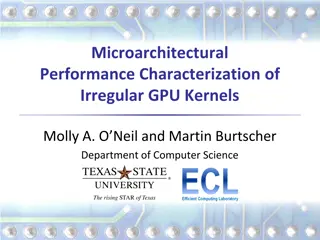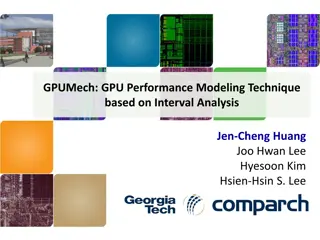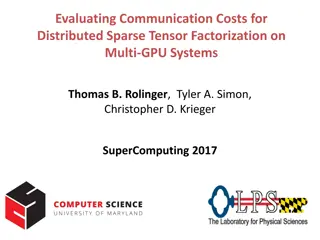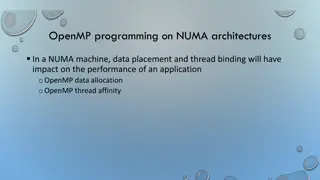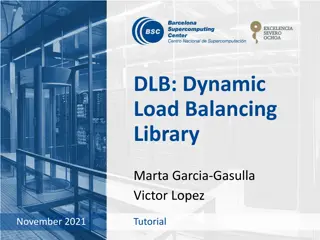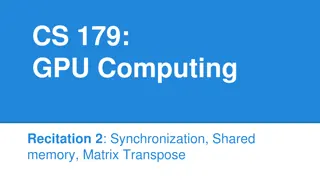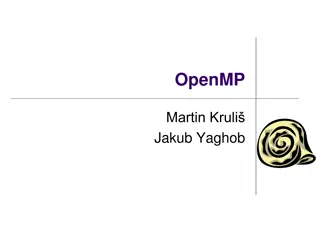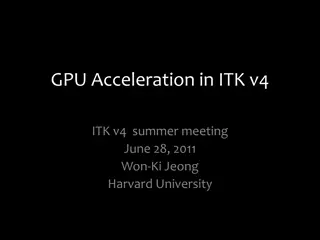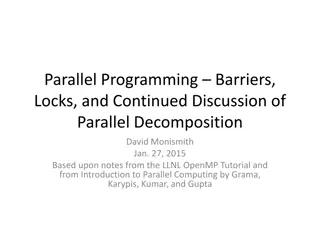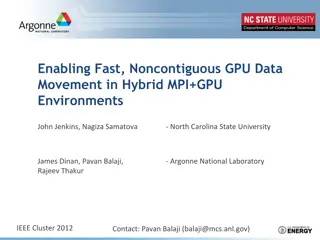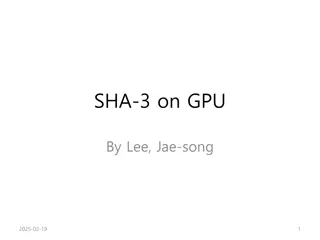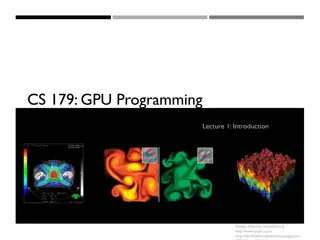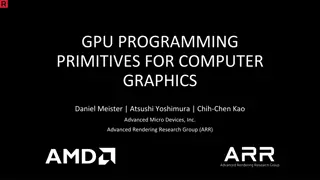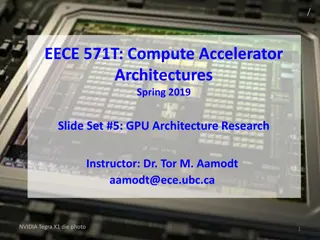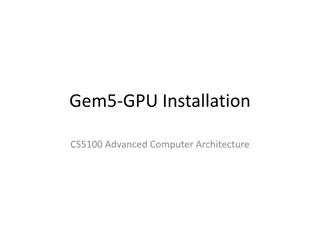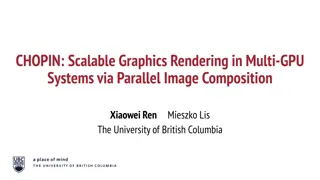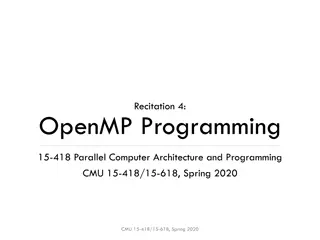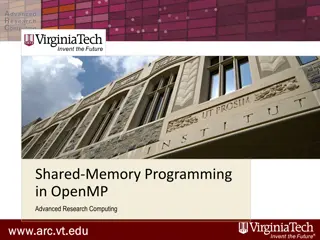
Understanding OpenMP Offloading to GPUs and its Performance
Learn how to utilize OpenMP on GPUs for enhanced performance, exploring thread hierarchy, data management, and benchmark evaluation on NVIDIA V100 GPUs across different platforms.
Download Presentation

Please find below an Image/Link to download the presentation.
The content on the website is provided AS IS for your information and personal use only. It may not be sold, licensed, or shared on other websites without obtaining consent from the author. If you encounter any issues during the download, it is possible that the publisher has removed the file from their server.
You are allowed to download the files provided on this website for personal or commercial use, subject to the condition that they are used lawfully. All files are the property of their respective owners.
The content on the website is provided AS IS for your information and personal use only. It may not be sold, licensed, or shared on other websites without obtaining consent from the author.
E N D
Presentation Transcript
OpenMP: A technical overview Christopher Daley GPUs for Science July 2 2019
Overview OpenMP works extremely well on the CPU: #pragma omp parallel for [simd?] for (j=0; j<N; j++) a[j] = b[j] + scalar*c[j]; How do we use OpenMP on GPUs? How well does it perform?
OpenMP thread hierarchy for accelerators Execute code on device #pragma omp target #pragma omp teams No synchronization between thread teams except for atomics No barrier, critical section or locks League of N teams #pragma omp parallel Model familiar to OpenMP < 4.0 programmers Team 2 M threads Team 0 M threads Team 1 M threads (Image modified from OpenMP 4.5 target by Tom Scogland and Oscar Hernandez. Presented at ECP OpenMP tutorial 06-28-2017)
A 1stOpenMP target offload program #define N 128 double x[N*N]; int i, j, k; for (k=0; k<N*N; ++k) x[k] = k; OpenMP implicitly moves data between the host and device: Array x mapped to and from Scalars are made firstprivate #pragma omp target #pragma omp teams distribute for (i=0; i<N; ++i) { #pragma omp parallel for for (j=0; j<N; ++j) { x[j+N*i] *= 2.0; } } Distribute for loop iterations between teams Distribute for loop iterations between threads
Data management must be explicit when using pointer variables #define N 100 double *p = malloc(N * sizeof(*p)); Value of P[0] at different times Time Host Device A 2.0 B 2.0 C 2.0 D 4.0 #pragma omp parallel for for (int i=0; i<N; ++i) p[i] = 2.0; A N/A 2.0 4.0 N/A B #pragma omp target map(tofrom:p[0:N]) #pragma omp teams distribute parallel for for (int i=0; i<N; ++i) p[i] *= 2.0; C D target data can be used to keep data on the device for multiple target regions
OpenMP on an NVIDIA V100 GPU 80 Streaming Multiprocessors (SMs) 160 CUDA cores per SM Execute on multiple SMs OpenMP teams distribute (XL, Clang, Cray, GNU) Execute on multiple CUDA cores OpenMP parallel for (XL, Clang) OpenMP simd (Cray) OpenMP parallel for simd (GNU) (Image from NVIDIA Tesla V100 GPU Architecture whitepaper)
Can OpenMP applications achieve high performance on GPUs? We evaluated 5 OpenMP benchmarks on two platforms with NVIDIA V100 GPUs Summit 2 x IBM Power 9 CPUs 6 x NVIDIA V100 GPUs Cori-GPU 2 x Intel Skylake CPUs 8 x NVIDIA V100 GPUs 1. STREAM 2. Matrix transpose 3. Laplace equation 4. BerkeleyGW mini-app 5. SPEC-ACCEL XL-16.1.1 PGI-19.1 (OpenACC) Cray-8.7.7 Clang-9.0.0-git GCC-8.1.1-git Intel-19.0.3.199 (CPU-only) Benchmarks always use 1 CPU socket and 1 GPU and fit in GPU memory capacity
#1 STREAM benchmark: Most compilers obtain close to peak memory bandwidth #pragma omp target teams distribute parallel for [simd?] for (j=0; j<N; j++) a[j] = b[j] + scalar*c[j]; The simd construct is not needed for Cray compiler but is needed for the GCC compiler.
#2 Transpose benchmark: More of a performance difference between compilers #pragma omp target teams distribute parallel for collapse(2) for (y = 0; y < NY; ++y) for (x = 0; x < NX; ++x) odata[IDX(x,y)] = idata[IDX(y,x)]; Tiling the two loops above improves L1 cache reuse Two compilers can use GPU shared memory to obtain higher performance PGI pragma acc cache XL team private array
#3 Laplace equation benchmark: Open- source compilers are less competitive The Jacobi relaxation calculation involves a stencil update and data reduction Slow kernel launch time and OpenMP reductions in the open- source compilers
Productivity: Can OpenMP target regions run efficiently on the host CPU? #pragma omp target teams distribute parallel for versus #pragma omp parallel for An OpenMP target region will run on the host CPU when 1. Compiling the application with a compiler flag setting the target device to host 2. Using an if clause on the OpenMP target construct 3. Setting the environment variable OMP_TARGET_OFFLOAD to DISABLED (OpenMP-5.0)
OpenMP target version is slower on the host CPU than OpenMP parallel for loops STREAM Triad O(1-10ms) per kernel Laplace (grid size of 10002) O(100 s) per kernel Slow + incorrect results!
This motivates using different OpenMP constructs for CPU and GPU execution Using preprocessor: #ifdef GPU # pragma omp target teams distribute parallel for #else # pragma omp parallel for #endif for (i=0; i<N; ++i) y[i] = a*x[i]; Using OpenMP-5.0 metadirective: #pragma omp metadirective \ when(device={arch(gpu)}: target teams distribute parallel for) \ default( parallel for)) for(i=0; i<N; ++i) y[i] = a*x[i];
#4 GPP benchmark: 3 compilers are within 15% of tuned CUDA The GPP mini-app contains the self-energy computation from the material science application, BerkeleyGW The mini-app has a single compute-bound GPU kernel invoked once GCC = 28.5s Results from: Rahul Gayatri, Optimizing Large Reductions in BerkeleyGW on GPUs Using OpenMP and OpenACC , NVIDIA GTC-2019
Placing all OpenMP constructs on 1 line helps GPP performance across compilers This simplifies compiler code generation and allows us to ignore the compiler- specific mapping of loop constructs to GPU hardware // The LLVM/Clang compiler refers to this as an SPMD code pattern #pragma omp target teams distribute parallel for simd collapse(2) \ reduction(+:ach_re0, ...) for(...) { for(...) { for(...) { for(...) { // ... simd is needed to avoid a 62x slow-down with the Cray compiler. It does not affect XL or Clang performance
#5 SPEC-ACCEL: Cray and LLVM/Clang correctly run all the C benchmarks Cray has the highest performance in 6/7 benchmarks 39x performance difference between Cray and LLVM/Clang!
Loop construct mapping explains 39x performance difference for 570.pbt Must move parallel for to innermost loop for LLVM/Clang #pragma omp target teams distribute parallel for private(i,k) for (j = 1; j <= gp12; j++) { for (i = 1; i <= isize-1; i++) { #pragma omp simd private(pivot,coeff) for (k = 1; k <= gp22; k++) { 100 iterations in each of j, i, k loops Table shows total time in 3 kernels: x_solve.c:708 (code fragment above) y_solve.c:689 z_solve.c:691 Before (s) After (s) Cray 5.0 5.0 LLVM/Clang 440.4 3.6
Preparing OpenMP applications for the CPU+GPU nodes of Perlmutter Try to use combined OpenMP compute constructs #pragma omp target teams distribute parallel for simd collapse(N) Minimize use of double/triple pointers and nested data structures in offloaded code regions More complicated to map between host and device Unlikely to perform well More data transfers between CPU and GPU Indirection in GPU kernels prevents coalesced memory access Test your application using the OpenMP compilers on Cori-GPU: we recommend LLVM/Clang for C/C++ and Cray for Fortran
OpenMP in Perlmutter timeframe NEW: The PGI compiler will provide OpenMP GPU acceleration Part of an NRE effort between NERSC and NVIDIA/PGI The open-source Clang/Flang compilers will continue to improve OpenMP-5.0 features will help productivity and performance on GPUs Unified Virtual Memory: Easier to get up and running on the GPU even with codes containing double/triple pointers, nested data structures and C++ STL containers Please be aware that these programming abstractions may not perform well on the GPU Memory Allocators: Enables portable use of GPU shared memory
Conclusions Directive-based programs can perform close to the hardware peak / CUDA The XL compiler shows that OpenMP performance can be competitive with OpenACC We expect PGI s OpenMP compiler to perform well on Perlmutter Performance portability remains a challenge Short-running OpenMP target regions are not competitive on CPUs Compilers map OpenMP constructs to GPUs in different ways Combined constructs mitigate this issue
The V100 memory hierarchy and the matrix transpose algorithm 128 KB combined L1 / shared memory per SM 1. Tile loops to use L1 cache 2. Tile loops and do the transpose in a team private array allocated in GPU shared memory -- IBM compiler only (Image from VOLTA Architecture and performance optimization by Guillaume Thomas-Collignon and Paulius Micikevicius at GTC-2018)
Structuring the matrix transpose to use GPU shared memory with IBM compiler #pragma omp target teams distribute collapse(2) for (xtile = 0; xtile < NX; xtile += TILE_DIM) { for (ytile = 0; ytile < NY; ytile += TILE_DIM) { double tile[TILE_DIM][TILE_DIM+1]; # pragma omp parallel for collapse(2) // ... for loops to do the transpose All strided accesses involve tile array only (Image from An Efficient Matrix Transpose in CUDA C/C++ by Mark Harris for Nvidia web article)
Performance is highest when using the GPU shared memory resource Matrix transpose with IBM XL-16.1.1 gld_efficiency (%) gst_efficiency (%) 100 25 100 25 25 100 25 100 100 100 A 25% efficiency indicates that only 8 bytes are used in each 32 byte memory sector
Code-gen paths in LLVM/Clang SPMD mode (fast) As used in GPP General mode (slower) As used in 570.pbt #pragma omp target teams distribute \ parallel for collapse(2) for (j=0; j<N; ++j) { for (i=0; i<N; ++i) { // .. do work .. #pragma omp target teams distribute // User code in between target // and parallel regions for (j=0; j<N; ++j) { #pragma omp parallel for for (i=0; i<N; ++i) { // .. do work .. The team master thread executes all code and wakes up worker threads to execute parallel region All threads execute all code
OpenMP target offload compilers on Cori-GPU LLVM/Clang is the most robust OpenMP offload compiler on Cori-GPU Upstream: PrgEnv-llvm/9.0.0-git_20190220 Patched branch supports calls to math.h functions in OpenMP target regions: PrgEnv-llvm/9.0.0-git-patched-upstream_20190305 The Cray compiler delivers good performance but sometimes fails to compile relatively simple programs It is the best option for Fortran applications on Cori-GPU The GNU compiler generally delivers very poor performance Please see https://docs-dev.nersc.gov/cgpu/software/
STREAM performance is unaffected by use of Unified Memory The code fragment shows how to combine OpenMP-4.5 and CUDA to use unified memory cudaMallocManaged((void**)&a, sizeof(double) * N); cudaMallocManaged((void**)&b, sizeof(double) * N); cudaMallocManaged((void**)&c, sizeof(double) * N); #pragma omp target teams distribute \ parallel for is_device_ptr(a, b, c) for (j=0; j<N; j++) a[j] = b[j] + scalar*c[j]; Note: STREAM benchmark excludes data transfer time between CPU and GPU
Flang provides an initial implementation of OpenMP target offload to NVIDIA GPUs STREAM Triad in Fortran The Flang compiler currently only supports SPMD mode It has many bugs and is not ready for general use yet It did achieve over 450 GB/s for STREAM Triad on Nvidia V100 - the same as Clang-7.0.1
Programmability concern #1: mapping nested data structures #define N 10 typedef struct myvec { size_t len; double *data; } myvec_t; myvec_t *p = init_myvec(N); Bitwise map of N myvec_t structs For each myvec_t, map host data and attach to device pointer data #pragma omp target enter data map(p[0:N]) for (int i=0; i<N; ++i) { #pragma omp target enter data map(p[i].data[0:p[i].len]) }
Programmability concern #2: mapping multi-dimensional arrays #define N 10 double** p; // ... create dynamic 2d array: p[0:N][0:N] Map N pointers #pragma omp target enter data map(to:p[0:N]) for (i=0; i<N; i++) { #pragma omp target enter data map(to:p[i][0:N]) } Attach data to each p[i] pointer #pragma omp target teams distribute parallel for collapse(2) for (i=0; i<N; i++) { for (j=0; j<N; j++) { p[i][j] *= 2.0;
Programmability concern #3: mapping C++ STL containers std::vector <double> vec; // C++ STL vector double *p; size_t len; double vec_sum; // ... initialize C++ vector Can t map std::vector. Must map a pointer p to the vector data p = vec.data(); len = vec.size(); #pragma omp target map(to:p[0:len]) map(from:vec_sum) #pragma omp teams distribute parallel for reduction(+:vec_sum) for (int i=0; i<len; i++) { vec_sum += p[i]; Access vector data through p


